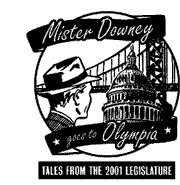Olympia Democrats didn’t know quite what to expect in this year’s session from their leader in the House of Representatives, Frank Chopp. They sure didn’t expect Chopp’s first priority to be picking a party-splitting, no-win fight over buying a bridge.
In the usual Olympia way of things, Chopp would not have been the Democrats’ first choice to front them. Lynn Kessler of Hoquiam had the strongest claims, but with four-fifths of its members elected from urban districts, the caucus wanted a city kid at the helm. The obvious candidate, Helen Sommers of Seattle, had her heart set on being cochair of the Appropriations Committee. And Chopp—with a lifelong record of campaigning for the rights and well-being of the poor, aged, sick, and disadvantaged—certainly had the requisite liberal credentials.
Imagine the Democrats’ bewilderment, then, when Chopp jumped, feetfirst and without consultation, into a fight over funding a new suspension bridge over the Tacoma Narrows. The bridge has been in the works for nearly a decade. It enjoys strong support (and no powerful opposition) in both parties. A contract has already been signed between the Department of Transportation and a subsidiary of the worldwide engineering firm Bechtel. Construction is due to begin in July. Why reopen the question now?
Chopp says all he wants to do is save taxpayers and toll-payers a bunch of money. Under the present plan, Bechtel would finance the bridge up front by borrowing in the money markets; Chopp contends that if the state borrowed the money, it would pay as much as half a billion dollars less in interest over the life of the loan, thereby holding tolls down too.
Great policy and politics both if that were the whole story, but of course, it isn’t. The state’s contract with the Bechtel subsidiary runs to literally thousands of pages; changing it at this late date means delay, and delay costs money: money to the lawyers who rewrite the contract, money to the lawyers defending the state from an almost certain suit for breach of contract, money, money, money, while Pierce County’s commuters stew in traffic.
Politically, Chopp’s opposition to going ahead with the bridge as planned is a puzzle: It’s a hot issue in Gig Harbor and Port Orchard, but a big yawn for Chopp’s constituents in Wallingford, Madison Park, and North Capitol Hill. And putting the power of his office as party leader in play against the bridge was a slap in the face to the ranking Democrats most concerned with the issue, Senate Transportation Committee Chair Mary Margaret Haugen of Camano Island and her equivalent in the House, Tacoma’s Ruth Fisher, both already publicly committed to the deal. “Those ladies between them have been in state politics six times as long as Frank,” says one House member whose politics generally align with Chopp’s. “This was a serious breach of legislative manners.”
Democrats were in the minority in the House when Chopp arrived there in 1994, and just last year, they finally worked their way to a tie with the GOP. Chopp has had little experience wielding power in this highly collegial environment, but that still doesn’t explain his choice of a first issue to go to the mat for.
Chopp got into politics as a wildcat citizen activist, fighting The Seattle Times‘ imperial plans for the Cascade neighborhood from his geodesic squatter’s dome there. He spent the next quarter-century learning to leverage the governmental machine in the interests of the poor, sick, aged, and otherwise disadvantaged, over the last 17 years turning his Fremont Public Association into a powerful player in the social services field.
From a liberal Democratic perspective, the most dominant issue by far in the 2001 legislative session should be rescuing the Department of Social and Health Services budget from draconian cuts proposed by the soulless number crunchers in Governor Locke’s Office of Financial Management. What’s a barefoot populist doing spending precious political capital on saving prosperous Pierce County commuters a couple dollars a day in bridge tolls?
A high-minded explanation might be that populists don’t like neo-con innovations like public-private partnerships to build essential social infrastructure, be they schools, prisons, or bridges. The second Narrows bridge is the last survivor of a number of such projects first bruited back when Republicans looked to rule Olympia forever, and some think Chopp’s grenade was meant not to change how it’s funded but to dynamite the whole concept once and for all.
That could prove a boon for Chopp one day back home. One of the public-private projects being considered when Chopp arrived in Olympia in 1994 was a supplementary span for SR-520 across Lake Washington. The western approach to such a bridge would have to lie along the south shore of Union Bay, the most prosperous part of Chopp’s prosperous district. Coincidence? You be the judge.








